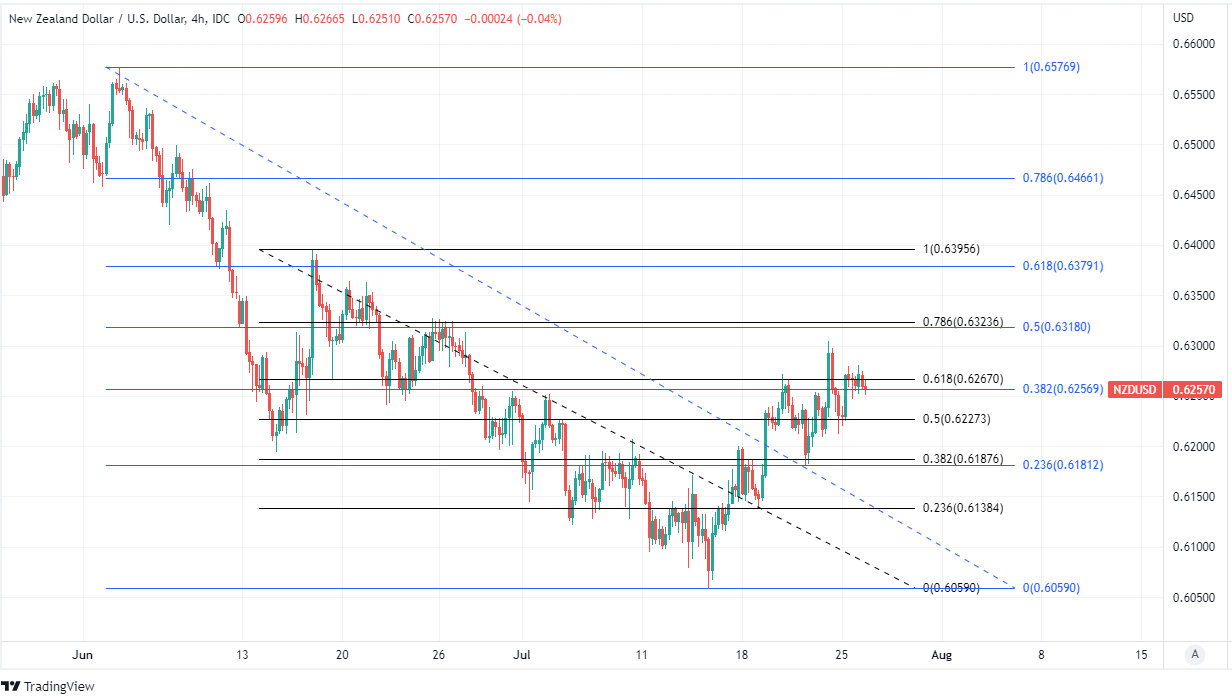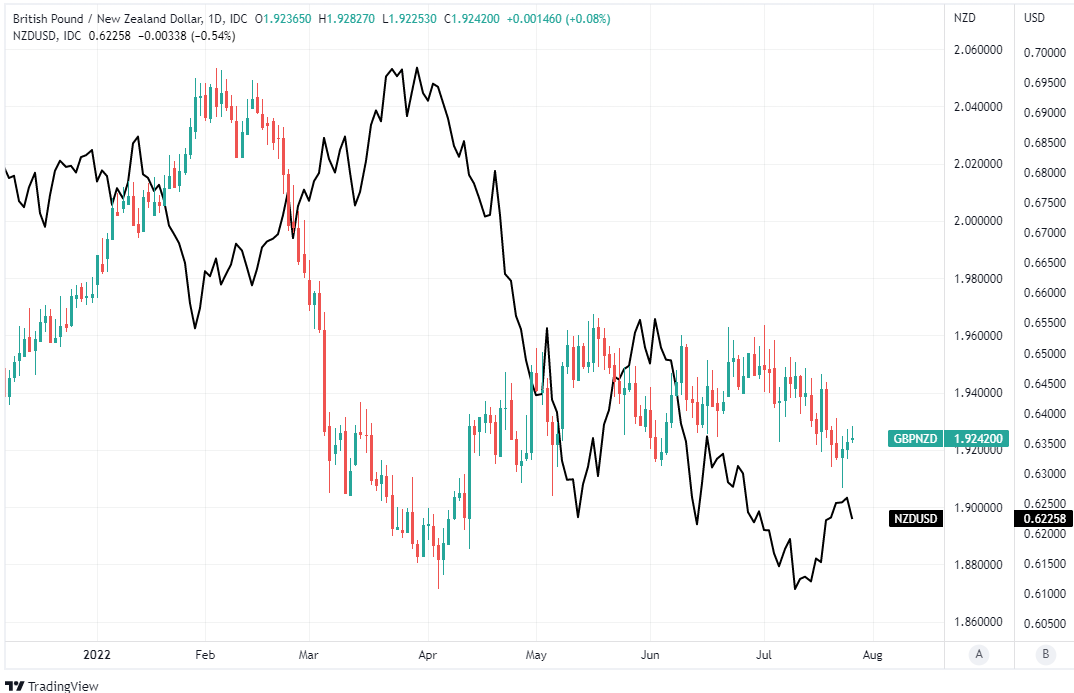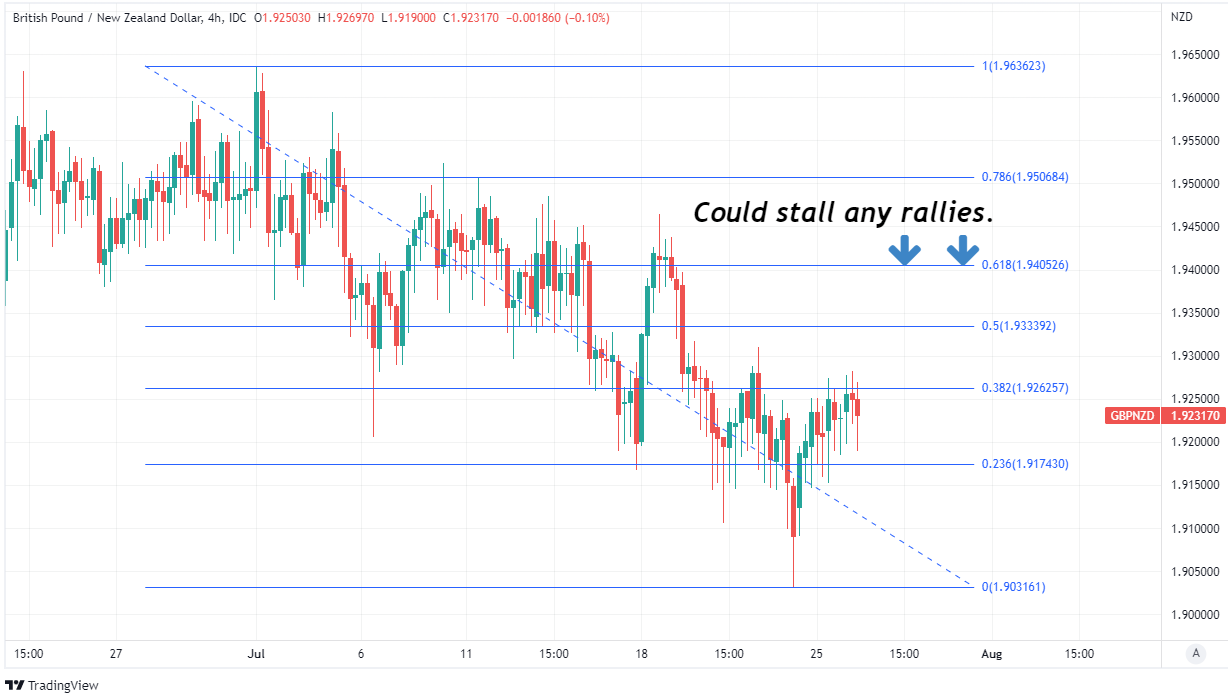GBP/NZD Rebound Could Struggle to Get Off Ground
- Written by: James Skinner
-
- GBP/NZD rebounds but risks further slippage below 1.92
- GBP/NZD well supported above April lows around 1.9035
- 3-month range spanning 1.9035 to 1.9671 set to persist
- NZ confidence data, Fed decision & U.S. GDP in focus

Image © Adobe Stock
The Pound to New Zealand Dollar rate entered the new week on the front foot but may be at risk of another flush below the 1.92 level and could struggle to get far off the ground amid a busy schedule of event risks in the days ahead.
New Zealand’s Dollar was softer against Sterling and some other major currencies on Tuesday as the U.S. Dollar rebounded from 10 day lows against most of its G20 counterparts, leading to a third day of gains for GBP/NZD.
GBP/NZD climbed back above 1.92 in early trading this week but had fallen below 1.91 previously as risky assets pared recent losses and the U.S. Dollar eased from its early July peaks against most currencies.
This lifted the influential NZD/USD pair near to 0.63 in the process.
“While the NZD hit the 0.63 mark last week, we see that sort of level as a good selling opportunity, ahead of potentially new lows being traded later this year,” says Jason Wong, a senior markets strategist at BNZ.
“In our view, the NZD continues to face macroeconomic headwinds and global growth downgrades often go hand-in-hand with a weaker NZD,” Wong and colleagues aso said.
 Above: Pound to New Zealand Dollar rate shown at hourly intervals and alongside NZD/USD. Click image for closer inspection.
Above: Pound to New Zealand Dollar rate shown at hourly intervals and alongside NZD/USD. Click image for closer inspection.
Global market risk appetite and direction of the U.S. Dollar have both been important influences in recent times, and a source of pressure on many currencies for the most part including the New Zealand Dollar and Sterling.
The Federal Reserve response to rising inflation has been a prominent driver of the rally that lifted the U.S. Dollar Index to its highest level for two decades earlier this month, which weighed heavily on many currencies.
But in July the market’s concerns about risks to energy supplies in Europe have also seen the Dollar weighing most heavily on European currencies, leading both GBP/NZD and EUR/NZD to fall throughout the period despite widespread risk aversion in global markets.
This has pulled Pound to Kiwi rate back toward the bottom of a three-month range spanning the gap between 1.9035 and 1.9671, although where GBP/NZD heads next is heavily dependent on Wednesday’s Fed policy decision and the raft of economic data due out from the U.S.
“Data over the rest of the week may prove to be pivotal for medium-term levels for the NZD. How hawkish the FOMC is, along with US data on wages and inflation, may set the tone for DXY [Dollar Index],” says Finn Robinson, an economist at ANZ.
Above: Pound to New Zealand Dollar rate shown at 4-hour intervals with Fibonacci retracements of July decline indicating possible areas of technical resistance. Click image for closer inspection.
Wednesday’s Fed decision will be impactful because of what it says about the likely path of interest rates in the months ahead, which could affect market appetite for the U.S. Dollar and many other currencies including the GBP/NZD and NZD/USD exchange rates too.
“The 0.6330 area continues to provide resistance near term. Multi-week, we remain cautious,” says Imre Speizer, head of NZ strategy at Westpac, in reference to NZD/USD, which has an influence on GBP/NZD.
“The main drivers of NZD/USD at present remain global risk sentiment (recession risks are growing) and the US dollar (hawkish Fed). Even further ahead, though, by year end, if sentiment stabilises, there is potential for the NZD to rebound towards 0.68,” Speizer added on Tuesday.
The Fed set itself on course in June to lift U.S. rates to a “modestly restrictive” level by year-end but also indicated that once at the estimated neutral level - thought to be around 2.5% and likely to be reached this week - it could reevaluate the speed at which it moves going forward.
 Above: NZD/USD shown at 4-hour intervals with Fibonacci retracements of early June and mid-June declines indicating possible areas of technical resistance. Click image for closer inspection.
Above: NZD/USD shown at 4-hour intervals with Fibonacci retracements of early June and mid-June declines indicating possible areas of technical resistance. Click image for closer inspection.
Much about the future pace likely depends on how quickly the U.S. economy responds to the actions taken thus far, and there have been signs of the Fed’s policy already having the desired effect of cooling the economy including the recent trend of hiring freezes at the largest of U.S. companies.
“The slowdown in activity appears to be broadening with the Composite PMI index falling below 50 in July amid surprising weakness in the services sector,” says Tom Kenny, an economist at ANZ.
As a result there is a risk or chance of the Fed signalling as soon as this week that the pace of rate rises would slow if the economy itself slows quicker than the bank had been anticipating, and this is something that would potentially curb market appetite for the U.S. Dollar.
That would be a highly supportive outcome for the New Zealand Dollar, which offers one of the highest interest rates among major currencies, and a likely headwind that could pull GBP/NZD back below the recently recovered 1.92 handle later in the week.
 Above: Pound to New Zealand Dollar rate shown at daily intervals and alongside NZD/USD. Click image for closer inspection.
Above: Pound to New Zealand Dollar rate shown at daily intervals and alongside NZD/USD. Click image for closer inspection.
Much also likely depends on whether Thursday’s U.S. GDP data reveals a second consecutive quarter of economic growth, however, as this would place the economy into what is known as a technical recession, although how the U.S. Dollar would respond remains an open question.
“If the recession is interpreted as isolated to the US, the USD could fall. But if the recession is seen as a prelude to recession elsewhere, the USD could jump as the preeminent safe haven currency,” says Joseph Capurso, head of international economics at Commonwealth Bank of Australia.
Meanwhile, and along the way, the Kiwi may well be responsive to Thursday’s ANZ Business Confidence barometer, which will provide insights into the impacts of Reserve Bank of New Zealand (RBNZ) interest rate policy and high levels of inflation that are squeezing incomes and living standards.
“Crisis or not, the parlous state of both business and consumer confidence is, and will be, a critical determinant in the evolution of the New Zealand economy over the next twelve months,” says Craig Ebert, a senior economist at BNZ.
“Morose householders do not spend, and upset businesses neither hire nor invest. When both businesses and consumers are unhappy then there is little chance that an economy will flourish,” Ebert and colleagues said on Monday.





